21 Best Dry Flies For Trout Used By Top Guides
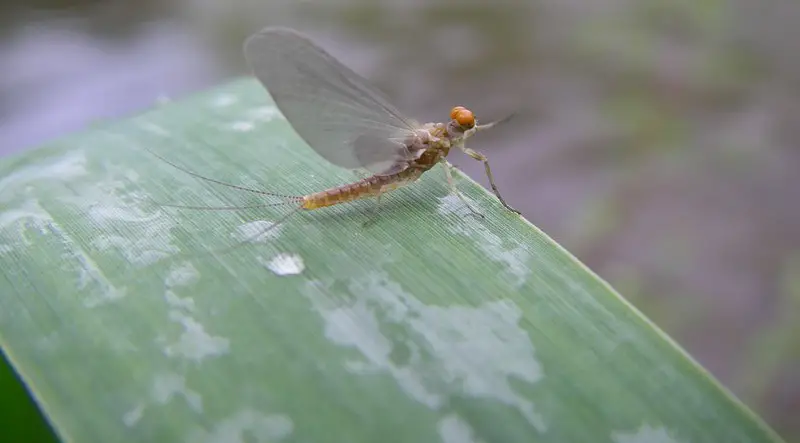
I’m going to let you in on a secret about dry flies for trout that other websites don’t want you to know. Often, the most recommended trout dry flies you see on-line are not the ones that river guides and top anglers use.
But don’t worry, while other websites show you all the same generic dry flies, I’ll show you the better dry flies that top trout guides and top anglers are using.
When considering dry fly fishing for trout, the best dry flies will closely imitate insects like mayflies, stoneflies, and caddis, and often the best dry flies for bigger trout are the sparsley-tied ones.
However, at times, the best dries are attractor patterns that can resemble multiple types of insects. Let’s find out why and which flies are the most effective for trout fishing.
Guide Dry Flies VS Generic Dry Flies For Trout
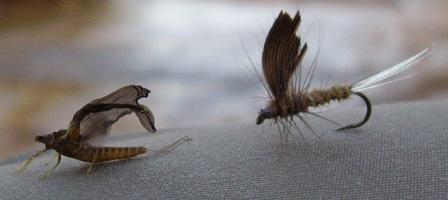
Look into the dry fly box of an average or new fly angler, and then look into the dry fly box of guides and experienced anglers and you will see very different dry flies.
I’ve looked into many guides dry fly boxes, as well as top competition anglers boxes, and even a world champion competition fly anglers box, and they all use very different dry flies than the rest of the fly fishing community.
There are two reasons for this. Testing and sharing!! Guides and competition anglers constantly test out new flies in all sorts of conditions. When they find great dry fly patterns they share them with their guide buddies or the rest of their fly fishing team, and sometimes with some lucky clients.
There is also a reason why regular anglers mostly use generic dry fly patterns for trout.
Many of the dry flies recommended on other websites are flies that those websites can make commissions on.
And, the ones the stores recommend to fly anglers are the ones they can sell. I know guys that work in fly shops, and the flies they sell in the stores are not the same as what’s in their fly boxes. Just saying!!
I’m not saying generic flies are bad flies, but if they were truly great dry flies for fishing trout, guides, and competition anglers would have boxes full of them, but they don’t!!
Why Dry Fly?
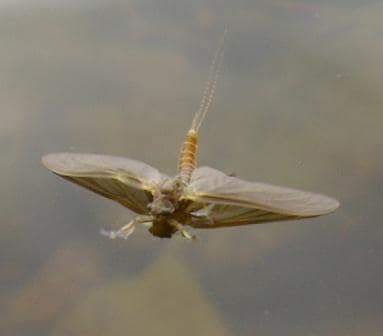
A dry fly is an artificial fly that I’mitates floating insects that trout feed on.
Insects are a huge part of a trout’s diet, but trout will feed on the surface only 5 % to 10% of the time.
In some warmer areas of the south, the numbers might be higher, and you might have an insect hatch year-round.
8 Proven Dry Fly Patterns For Trout
If I had to narrow down my dry fly patterns to only eight, these would be them.
- Elk Hair Caddis – It’s a classic, but it works well to imitate caddis.
- Stimulator – A great attractor pattern and a good fly pattern when you want to imitate an adult stonefly.
- Mayfly Dun – The best all-around mayfly dun pattern
- Comparadun – Good mayfly pattern when a low profile fly is needed for picky large trout.
- CDC Spinner – My best all-around spinner pattern.
- Beetle – A great summer pattern in the northern parts of the country but also good throughout the year in warmer climates.
- Hopper – A must-have and guide favorite for big trout in areas with grasshoppers.
- Ant – Another must-have seasonal fly pattern in areas with ants.
I have a lot more than this listed below because in some areas these flies won’t be good.
Guide Tip: When in doubt, go lighter and go smaller than what you see.
What I mean is that what anglers see is not what the trout see. We are looking down at flies on the surface, and the trout are looking up at them.
In many cases, the back of an aquatic floating insect is darker, and the belly is lighter or a different color. As a fly tier, I try to match the belly of the natural insect and not the back, and for this reason, many of my flies are lighter in color than what others use.
As an example see the two images below of the same green drake fly from my local trout river.
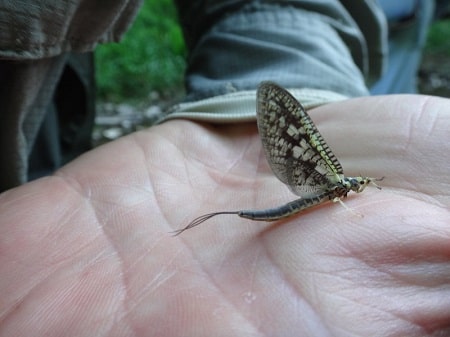
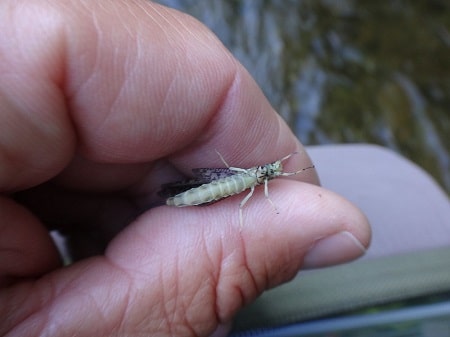
Types Of Dry Fly Patterns For Trout
1. Emergers
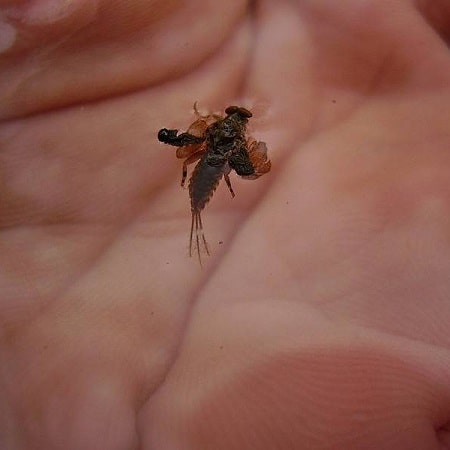
Emergers are mayflies in transition from a nymph to a dry fly and are often found floating on the surface of the water as their wings dry enough for them to fly.
Fished effectively, emergers can be very effective at taking large trout.
2. Duns
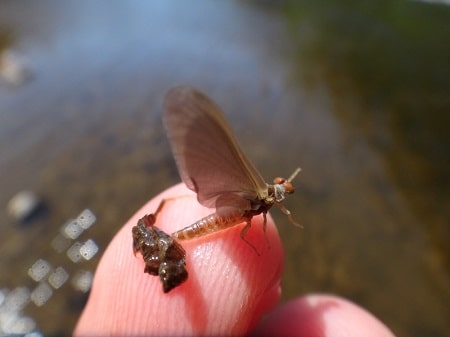
Duns are the immature adult version of mayflies and are often found on the water shortly after the nymphs have emerged. Trout love mayfly duns since they are abundant.
3. Spinners
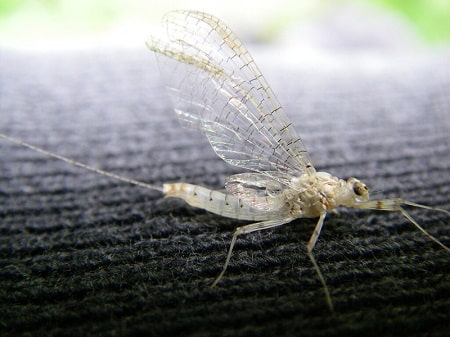
Spinners are the mature adult stage of mayflies and are when they are ready to drop their eggs on the surface of the water.
These adult insects will drop to the water in large numbers all around the same time, this is called a spinner fall and it usually occurs at dusk, and sometimes at dawn.
A Rusty Spinner dry fly pattern is a good imitation.
The sheer volume of the spinners and their predictability makes the spinner fall the time many anglers will fish and do very well with big brown trout and rainbow trout.
4. Attractor Dry Flies
Attractor flies are flies that are big, bulky, and stand out. They don’t imitate a natural bug very well, but they could be seen as many things to a trout. They can be great when no insect hatches are occurring.
They are also a good option for new fly fishers and for guys with poor vision since they stand out and float high.
5. Terrestrial Flies
Terrestrial flies are popular with fishing guides but not so much with regular anglers. Terrestrial flies are non-aquatic insects that live near the river. Insects like grasshoppers, crickets, beetles, or any flying or crawling bug.
6. Prey Dry Flies
I’m not exactly sure what to call these, so I call them prey dry flies. Prey flies are flies that imitate swimming prey like mice, frogs, salamanders, lizards ect. Basically, anything that might swim across the river or lake is fish food for big predator trout.
In fact, at certain times of the year, anglers will specifically target huge trout using mouse patterns with very good success. These are not must-have flies, but they are sure fun to catch fish on.
A simple deer hair mouse pattern can be great at dusk and give you quite a thrill.
Bushy Dry Flies VS. Sparse Dry Fly Patterns
Guide Tip: Bushy dry flies float much higher; however, the bushier the dry fly, the less it imitates the actual insect, which can prevent larger, wiser trout from biting. I have bushy dry flies for fly fishing, and I primarily use them for smaller trout or stocked trout.
I also have sparsely tied dry flies, which don’t float as well, but they fool big trophy-sized trout.
Proven Dry Flies For Fishing Trout
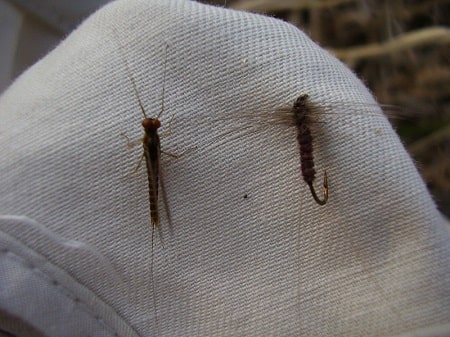
These are great dry flies for fishing trout that anglers should consider.
Guide Tip: I use the same simple mayfly pattern for all the different mayflies in my area since they are all basically the same shape.
I have been very successful with this for over 20 years. I simply change the color and size to match the natural. This means, the same pattern I use for a size 18 BWO also works for a size 12 March Brown.
I’ll even chop the tops and bottom hackles flat, and then that mayfly becomes a spinner just like the one above. Don’t overthink it guys!
Mayfly Imitations
1. Mayfly Dun Pattern
This is my most effective mayfly pattern and it’s my most versatile pattern if you tweak it slightly.
If I had to choose only one mayfly pattern, this would be it, and every angler should have plenty of these in their fly box.
It is sparsely tied, which makes it a better imitation of the real mayfly, and this is great for bigger trout that won’t touch a bushy pattern.
But, you can easily add a second hackle feather to make it bushier to ride higher, which is better in faster ripples and rapids.
I have even trimmed the top and bottom hackles off and left the side hackles, and it has become a good spinner fly pattern. I have also tied this with no wing, just the hackle and it can work equally as well and be much easier to tie.
You can see how versatile this fly pattern is.
I change the size and color to match any mayfly species, and when tied small, it is a great Blue Winged Olive imitation. I also use it as a March Brown, Gery Fox, Pale Morning Dun, Beatis, and just about any mayfly on any river.
Guide Tip: If you cut a v-shape into the hackle, your fly is more likely to land upright and sit upright. Without it, some flies roll or sit sideways on the water.
2. Comparadun Mayfly Pattern
The Comparadun Mayfly is another great fly that you will find in many guide fly boxes.
It is a great big trout pattern that can be tied very small, or large. This is a must-have fly and should be in any serious fly fisherman fly box.
Tied with CDC, deer hair, or elk hair and all will work.
Like the Mayfly Dun, you can change the color and size to match all the different mayflies near you.
I use the Comparadun tied small to imitate very small mayflies like the BWO and Tricos.
Guide Tip: Many dry flies are tied with the wings spread apart. However, when a mayfly is drifting on the water, almost always the wings are together and straight up. I’m not really sure why fly tyers tie dry fly wings apart, but a single wing works equally well and is much easier to tie.
CDC Spinner
This is a fantastic dry fly to initiate any mayfly in the spinner stage. Just tie it in the sizes and colors to match the hatch on your river.
The Rusty Spinner is another version that works and one that you can buy online or in the stores.
For very small spinners to initiate flies like the BWO or a Trico, consider the DM Small Spinner or something similar.
Guide Tip: When tying very small flies, especially mayflies and some nymphs, instead of using dubbing for the body, which creates bulk that makes the fly disproportional, I simply make the body out of tying thread.
Wyatt’s Deer Hair Emerger
I don’t fish emerges as often as I fish with duns.
The reason is simple: emergers sit very low in the water and are very hard for my clients to see, and at the same time, if there are emergers on the surface, soon after, there are also duns on the surface, or there are nymphs below the surfaces, and both are easier to fish with.
However, at times, the big trout only want emergers, and if that’s the case, I will fish emergers.
To help my clients with detecting bites, I will often add a micro swivel about 24 inches up the tippet and tell them to set the hook if anything rises, within a 24-inch radius of that indicator.
You can also use emergers with a post like the Pheasant Tail Emerger Parachute, or ones with wings like the Wyatt’s Deer Hair Emerger
Adams Fly and Parachute Adams
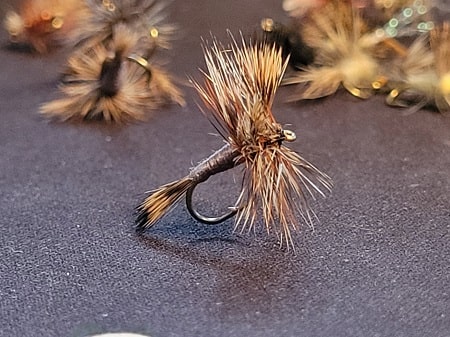
The Adams Fly in the standard dry fly pattern or in the Parachute Adams pattern represents many different types of mayflies, and it can be a great general-purpose mayfly for all trout species.
The thick hackle gives the fly more buoyancy.
The parachute post on the Parachute Adams fly patterns allows the fly to site lower on the water, which looks more natural, and the parachute post can be white, yellow, or orange which is great to help you see it.
This is one of those popular fly patterns that is a great fly in the dry fly box on any fly fisherman.
Royal Wulff – A classic dry fly
The Royal Wulff is buoyant and floats high which makes it great in faster water. I use it for any size trout, but I find it best for small to mid-sized trout. This fly is very similar to the Royal Coachman below.
Royal Coachman
A classic fly and a must-have if you fish brook trout. This fly does not necessarily imitate anything in particular, but it’s an attractor pattern that any hungry trout will eat, and many trout anglers know it.
Elk Hair Caddis
This is a fly you will find almost anywhere, and in all fly shops and even in guide boxes. The reason is it is one of the most effective dry fly caddis patterns available.
Other variations include the CDC Elk Hair caddis.
I also use the Elk Hair Caddis on a tight line with a method known as skittering or skating a caddis where you drag, twitch, and even hope your caddis across the surface. This can be deadly effective and is often my most effective method when trout are not rising for bugs.
The Olive X-Caddis is another good caddis imitation pattern you should check out.
Griffith’s Gnat Fly
A great dry fly pattern to imitate small flies like the trico and the midge is called the Griffith’s Gnat.
At times, midges are plentiful, and trout will be selective and only eat these micro flies, and this is when this fly is a good option.
This is a small fly, and it can be tied in colors that match the midge. For many anglers, it’s very hard to see, so some anglers, myself included, will add an orange, red, or white post to help see it.
Ant And Flying Ant Dry Fly
A black ant, or brown ant, or what some will call a cinnamon ant without wings, or a fly ant version can be a great option when there are plenty of ants on the surface.
Even when no ants are around, an ant pattern can be a good option.
The Black Foam Ant is a popular pattern worth having in your fly box, and one of my favorites is the Black Foam Ant by William Ensiferum.
Fishing with ant patterns on small streams in later summer can be very good. The ant is a small fly, so some ant patterns are tied with a colored parachute post to help the angler see it better.
The Stimulator
The Stimulator Fly is a bit larger of a fly that is meant to imitate stone flies, however, it can also imitate a grasshopper, large caddis, or adult helgramites. Most anglers know this fly, and since it is so big it looks like easy prey to the trout.
The Kauffman Stimulator is a popular pattern and is another great option is the Foam Body Stimulator.
This is an attractor pattern that can be tied with bright body colors like yellow, orange, and red. I’ve done very well on brook trout in fast water with this, but it can also be great on brown trout and rainbow trout.
Beetle Dry Fly
Dry fly beetles are a great bait during summer in many areas, but in year-round warm climates, the beetle is good anytime. I use darker-colored black and brown beetles but have also done well on yellow and orange beetles.
One of my favorites is the Tim’s Beetle seen in the above video/image.
Davies Cricket Dry Fly
The Cricket is a great fly pattern for me from June to late September, and I have had clients hook big cautious brown trout over 26 inches that refuse all other flies.
I even sometimes sink my cricket flies and nymph them. One of my favorite cricket fly patterns is the Davies Black Cricket.
Hopper Patterns
Hopper patterns like Daves Hopper can be fantastic dry fly patterns for big trout.
You’ll see guides and anglers casting at the grassy deep banks where trout are waiting for big meaty grasshoppers to fall in.
I use grasshopper patterns in the summer months but in some areas, grasshopper season is longer.
The Parachute Hopper is another popular pattern.
If you have a question, comment, or would like to share one of your favorite dry flies, let us know in the comments section below.
Tight Lines
Graham
Resources:

What sizes of each pattern should I carry in my fly box?
Hi Doug,
That’s a tough question. In some areas flies will be bigger or smaller. In general, for most trout flies, sizes 12, 14, and 16 should do it, but it also depends on the pattern. as an example, most of my BWO’s are size 18 to 22, and my Drakes are size 4 to 8.
Best of Luck
Graham